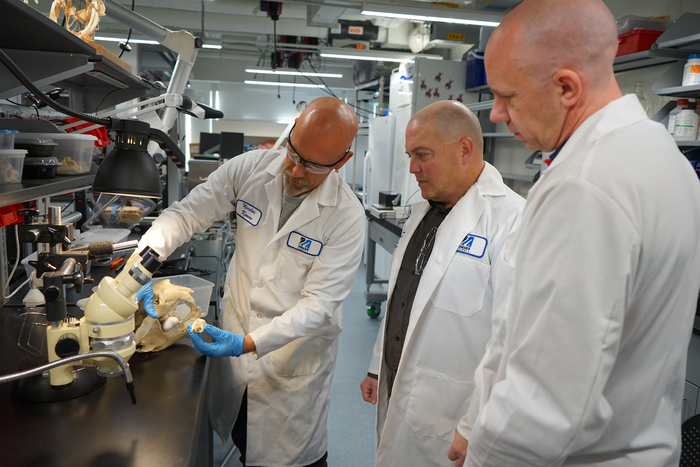Nov. 30, 2022

Credit: Brooke Coupal for UMass Lowell
Nov. 30, 2022
Media contacts:
Emily Gowdey-Backus, director of media relations, [email protected]
Nancy Cicco, assistant director of media relations, [email protected]
How does a squirrel produce enough jaw force to crack a nut?
The answer is: “It’s complicated.” But it has the potential to lead to new treatments for jaw-joint disorders, develop new dental protheses, fight diseases like muscular dystrophy, and more.
The National Science Foundation awarded $2.1 million to a team of scientists led by UMass Lowell to tackle this complex problem. Over the next three years, the team will study bite performance to determine whether the action is influenced primarily by muscle size and shape, skeletal geometry, or the presence of what’s known as “masticatory myosin,” a fibrous motor protein that enables muscles to contract. One of the questions the research hopes to answer is why this type of myosin is present in some animals, including sharks and grey squirrels, but not others, including humans and red squirrels.
The UMass Lowell researchers include biological sciences Assistant Professor Nicolai Konow, who leads the team, biological sciences Professor Jeffrey Moore and chemistry Associate Professor Matthew Gage. Joining them is Worcester Polytechnic Institute’s Sam Walcott, an associate professor of mathematical sciences.
Knowing how myosin, in its various forms, affects muscle force and velocity may lead to a better understanding of how muscles work and has the potential to signal how diseases develop, according to Konow.
“Muscle illnesses often have to do with myosin, so when we learn what the different protein variants are capable of, it might inform therapies,” he said.
To understand how masticatory myosin works, the team will first study its molecular properties, compare it to other, more well-known types of skeletal muscle myosins and then add it to a second protein found in muscles known as “actin.” In this way, researchers can see how myosin’s molecular properties contribute to the whole muscle.
Afterward, Konow will compare the biting abilities of red and grey squirrels to see how myosin impacts performance alongside other factors such as muscle size, bite type and the skeletal geometry of the rodents’ jaw and head.
Data gathered by Gage, Moore and Konow at UMass Lowell will be sent to Walcott at WPI where he will build predictive models of jaw performance and feeding abilities in squirrels and other rodents.
The data will also be used to create a computer game to teach high school biology students about how muscles work. In the game, players will be asked to manipulate different properties such as muscle size and protein content in order to successfully crack virtual nuts.
“This is exciting and can be really fruitful to scientists, because it’s often the inexperienced eye that sees the problem clearer than someone who has stared so long they’ve become blind to it,” Konow said.
UMass Lowell is a national research university located on a high-energy campus in the heart of a global community. The university offers its students bachelor’s, master’s and doctoral degrees in business, education, engineering, fine arts, health, humanities, sciences and social sciences. UMass Lowell delivers high-quality educational programs, vigorous hands-on learning and personal attention from leading faculty and staff, all of which prepare graduates to be leaders in their communities and around the globe. www.uml.edu




